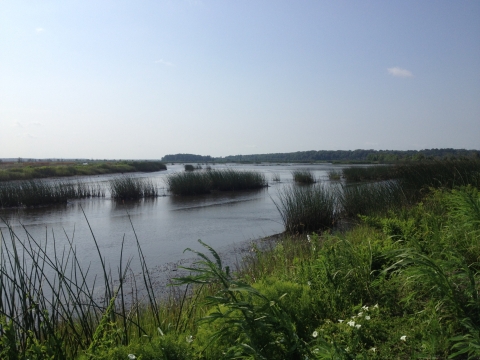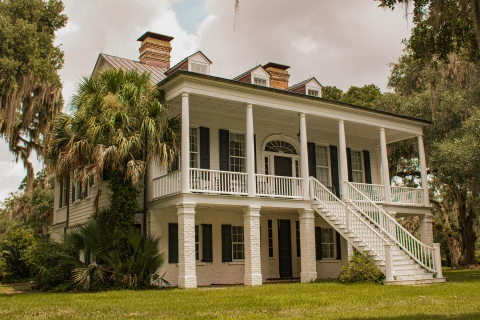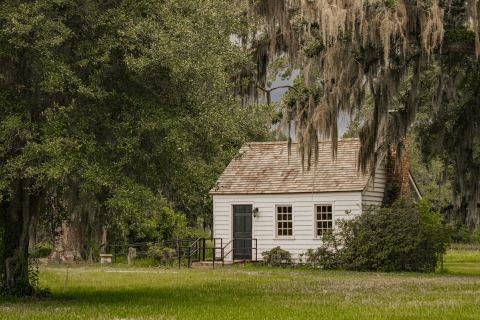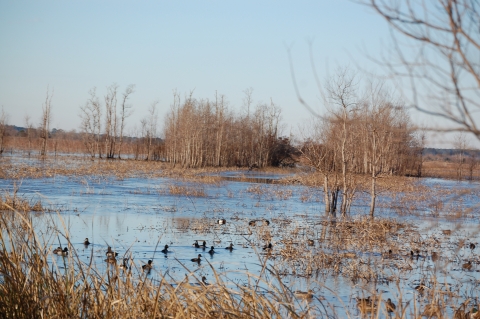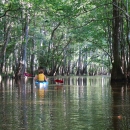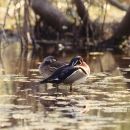About Us
ACE Basin NWR was established in September 1990 for its significance for wetland and habitat protection, migratory bird benefits and conservation opportunities served by the lands and waters of the refuge. In 2005, the refuge was renamed the Ernest F. Hollings ACE Basin National Wildlife Refuge (E.F.H. ACE Basin NWR) in honor of South Carolina's retired U.S. Senator Ernest F. Hollings. The refuge is located within the larger 350,000-acre Ashepoo-Combahee-Edisto (ACE) Basin system, widely recognized as a unique and critical environment for its wide diversity of wildlife and plants.
The E.F.H. ACE Basin NWR is composed of two units, comprising approximately 11, 815 acres. The Edisto Unit, at 7,203 acres, is located approximately 20 miles southwest of Charleston. The unit lies along the South Edisto River and includes the Grove Plantation – the Refuge Headquarters. The Combahee Unit, consists of 4,612 acres in Beaufort, Colleton and Hampton counties, and is located about 20 miles northwest of Beaufort. Drained by two river systems, the Combahee-Salkahatchie and South Edisto, the refuge contains exceptional wildlife habitat including forested wetlands and mixed pine and hardwood uplands, brackish and freshwater natural marshes, wetland management units, marsh islands, agricultural fields, and pristine estuarine rivers.
E.F.H. ACE Basin NWR provides haven for a vast array of birds, fish, and many other animals including endangered and threatened species. Threatened Wood storks forage and nest in managed wetlands and, endangered Shortnose sturgeon breed and feed in the Edisto and Combahee rivers. The neotropical Painted bunting, a Species of Continental Conservation Interest, finds nesting and foraging habitats in the forested edges, scrub thickets and upland fields during spring and summer months. Bald eagles and American alligators can be seen throughout the year.
The ACE Basin system represents the largest estuarine resource in South Carolina and, the Edisto River is the longest free-flowing blackwater river on the east coast of North America. The refuge, with its plethora of birdlife, is designated as an Important Bird Area by the National Audubon Society.
The refuge is steeped in cultural history with many historical values protected. Sixteen archaeological sites are identified on the refuge. The Grove House, a former rice plantation manor built in 1828, is one of a few antebellum mansions in the area that survived the Civil War and is listed on the National Register of Historic Places. Jehossee Island, a significant archeological area, has been assessed for eligibility for both a rural historic landscape and historic district.
The Grove Plantation – A Changing of Hands
The Grove Plantation, originally a land grant to Robert Fenwick in 1694, has had many owners through the years. From 1695 until 1825, the property changed hands nine times. At least eight additional parties would claim ownership of Grove Plantation from 1825 until the U.S. Fish and Wildlife purchased the property as part of the ACE Basin National Wildlife Refuge.
George Washington Morris purchased the land in 1825. He named it Grove Plantation and built the Grove House about 1828. The house was built in the late-Federal-period style of architecture, having the unusual feature of polygonal rooms and projecting symmetrical polygonal bays. Upon G.W. Morris’s death in 1834, the plantation passed from his wife to his son. The property was sold to John Berkeley Grimball in 1857, who combined his plantation Pinebury with the Grove and moved into the Grove house in 1858.
During the Civil War, both Pinebury and the Grove were sites of military activity with the Grove House, at one time, occupied by Confederate troops. By 1866, the Grove was considered abandoned, and the property confiscated by the government. John Grimball took the amnesty oath of loyalty to the United States, applied to the Bureau of Refugees, Freedmen, and Abandoned Lands, and was able to regain ownership of the Grove and Pinebury. After the war, he was unable to make mortgage payments on the Grove and the land reverted back to George W. Morris’ heirs in 1870.
The property then changed hands numerous times until it was purchased by Owen Winston in 1929. Winston did a restoration of the house. He added 5 dormer windows on the roof, put in 2 bathrooms on the north porch, removed the polygonal walls in the hallway and put in straight ones. Herringbone brickwork was added under both porches, wainscoting & doors installed, and outbuildings put in, including stables, an ice house, a 3 car garage, a barn, 2 residences, and a kitchen house.
By 1934, the Grove came under Thompson Brown’s ownership, He and his family used the plantation as a winter vacation residence and place to hunt waterfowl & deer. The Browns planted pecan, persimmon, cedar, palmetto, magnolia, and azaleas around the house. In 1947, the SC Power Company ran power lines to the house. The Browns sold the property in 1953.
R. Carter Henry purchased the Grove in 1964. The Henrys did an extensive renovation on the house. The stairwell in the foyer was changed to an open design, duck tiles were added around one fireplace and outbuildings were restored. R. C. Henry sold the Grove to A. Leigh Baier in the early 1970s.
During the Baier family's ownership, numerous rice field trunks (water control structures) were rebuilt or replaced and many of the dikes around the rice fields were repaired. Following Mr. Baier, Ralph and Margaret Hendricks owned the Grove until The Nature Conservancy purchased it in 1991.
The US Fish & Wildlife Service purchased the Grove Plantation in 1992. Renovations on the Manor were completed by the Service in 1996-1997. The Grove Manor houses the headquarters offices and visitor contact station of the refuge.
Our Mission
Refuge Purpose(s)
Each unit of the National Wildlife Refuge System is established to serve a statutory purpose that targets the conservation of native species dependent on its lands and waters. All activities on those acres are reviewed for compatibility with this statutory purpose.
Recognizing the importance of the ACE Basin system for wetland and habitat protection, migratory bird benefits and conservation opportunities served by the lands and waters of the refuge, the Service administratively designated ACE Basin NWR in 1990 under the Emergency Wetlands Resources Act of 1986, the Fish and Wildlife Act of 1956 and the Migratory Bird Act, thus outlining the primary purposes of these lands and waters:
“…the conservation of the wetlands of the Nation in order to maintain the public benefits they provide and to help fulfill international obligations contained in various migratory bird treaties and conventions…” 16 U.S.C. 390 1(b) (Emergency Wetlands Resources Act of 1986).
“…for the development, advancement, management, conservation, and protection of fish and wildlife resources…” 16 U.S.C. 742(a)(4) “…for the benefit of the United States Fish and Wildlife Service, in performing its activities and services. Such acceptance may be subject to the terms of any restrictive or affirmative covenant, or condition of servitude…” 16 U.S.C 742f(b)(1) (Fish and Wildlife Act of 1956).
“…for use as an inviolate sanctuary, or for any other management purpose, for migratory birds” 16 U.S.C. 715d (Migratory Bird Conservation Act).
“…to conserve and protect migratory birds…and other species of wildlife that are listed…as endangered species or threatened species and to restore or develop adequate wildlife habitat” 16 U.S.C. 715i (Migratory Bird Conservation Act).
Our Vision
Ernest F. Hollings ACE Basin National Wildlife Refuge provides resources for migratory birds, endangered species, and compatible public uses. Through motivated, experienced, and well-trained staff, volunteers and active partners, the refuge will strive to maintain the goals and objectives of the ACE Basin Project, a 350,000-acre estuary/ecosystem partnership between state, federal, corporate, private landowners, and non-governmental organizations. Through team development, the refuge will strive to be a model of excellence in natural resources management and celebrate our achievements with the public and our partners. The management of wildlife and habitat on the refuge will be an adaptive, science-based, comprehensive endeavor that links biological needs with resource management. The refuge will actively seek to expand partnerships that advance conservation stewardship and protection of natural resources. We will actively pursue research supporting the informational needs of the refuge while being able to adapt and being responsive to change. We will seek and develop appropriate and compatible public use opportunities and enhance awareness and appreciation of the refuge and National Wildlife Refuge System. Through outreach and public participation, the neighboring communities within the ACE Basin area will share our values for the National Wildlife Refuge System and a fish and wildlife heritage for all Americans.
Our History
1988 - The ACE Basin Task Force, a partnership of private land owners, government agencies and conservation organizations, launched the ACE Basin Project.
1990 - ACE Basin NWR was established in 1990 to provide a complex of habitats to conserve a significant wildlife ecosystem.
1992 - USFWS purchases the Grove Plantation for the refuge. The antebellum plantation house becomes the refuge headquarters and visitor center.
1993 - USFWS purchases Jehosee Island for the refuge.
2005 - Refuge renamed the Ernest F. Hollings ACE Basin National Wildlife Refuge to honor South Carolina retired U.S. Senator Ernest F. Hollings.
Other Facilities in this Complex
Encompassing over 115,000 acres, South Carolina Lowcountry Refuges Complex is home to four national wildlife refuges located in the coastal area known as the Lowcountry, the low lands extending from the Atlantic Ocean to the western sandhills. These public lands comprise some of the most unique and biologically diverse wetland and upland ecosystems along the Atlantic Coast. Within these landscapes are found one of only 20 Western Hemisphere Shorebird Reserve Network sites in North and South America, one of the largest undeveloped estuarine wetland systems remaining along the U.S. Atlantic coast, a critically endangered longleaf pine forest ecosystem and, the only known maritime sandhill community in the state.




